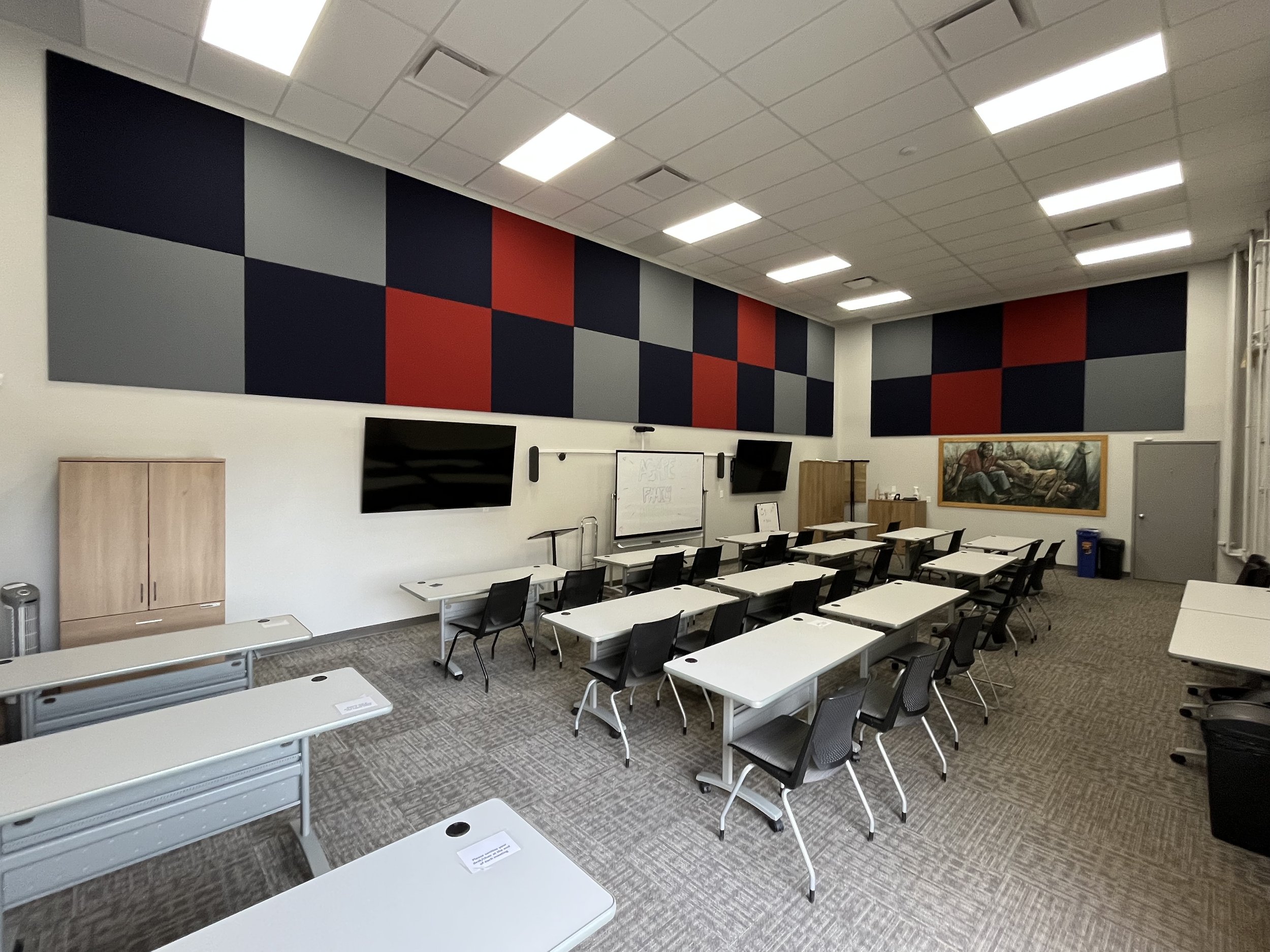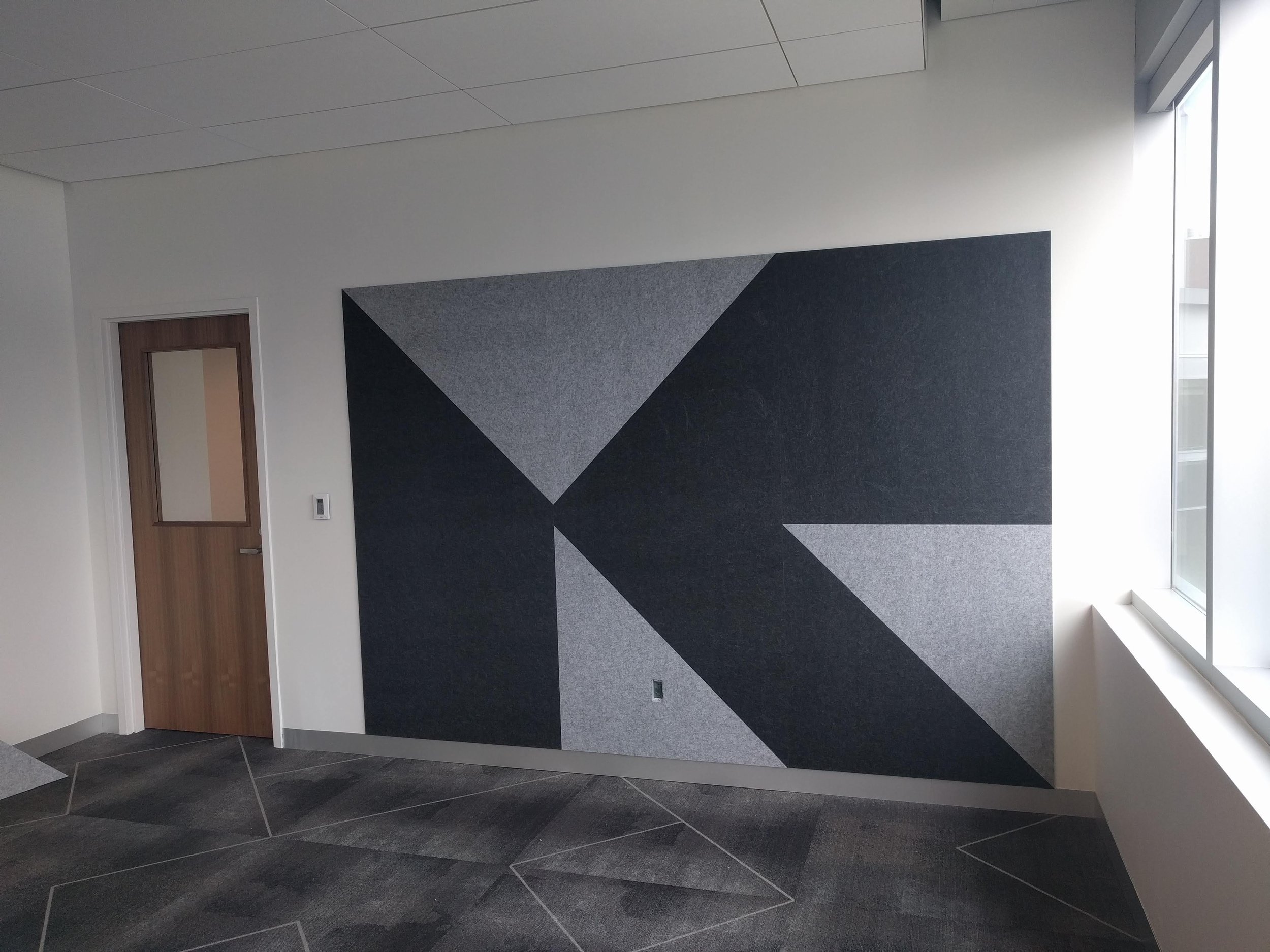
The Ultimate Guide to Installing Acoustic Wall Panels | Tips & Benefits
Acoustic wall panels have become increasingly popular in recent years, as people have become more aware of the impact that room acoustics can have on sound quality. These panels are designed to absorb sound waves, preventing them from bouncing off walls and creating unwanted echoes or reverberation.
The benefits of acoustic wall panels are numerous, and they can be used in a wide range of settings, from home theaters and recording studios to restaurants, classrooms, and office spaces. Installing these panels can improve speech intelligibility, reduce noise levels, and create a more comfortable and enjoyable listening experience for everyone in the room.
In this article, we'll provide you with the ultimate guide to installing acoustic wall panels. We'll start by explaining the science behind acoustics and how sound travels, and we'll discuss the benefits of acoustic treatments in general. We'll then dive into the specifics of choosing the right acoustic wall panels for your space, preparing your room for installation, and actually installing the panels.
We'll also cover tips for maintaining your acoustic wall panels, including how to clean and care for them, as well as best practices for ensuring they remain effective over time. Additionally, we'll discuss the benefits of hiring a professional installer, and we'll provide you with some real-world examples of successful installations and the benefits they provided.
By the end of this article, you'll have all the information you need to install acoustic wall panels in your own space and enjoy the many benefits they provide. So, let's get started!
Understanding Acoustics
To truly understand the importance of acoustic wall panels, it's essential to have a basic understanding of acoustics and how sound travels. Sound is created when an object vibrates, creating pressure waves that move through the air. These waves then strike our eardrums, which convert them into electrical signals that our brains interpret as sound.
The quality of sound that we hear can be greatly impacted by the acoustics of the room we're in. When sound waves bounce off walls, ceilings, and floors, they can create unwanted echoes and reverberations. This can make it difficult to understand speech, and it can negatively impact the overall listening experience.
Acoustic treatments, such as acoustic wall panels, are designed to absorb sound waves and prevent them from bouncing around the room. This can help to improve speech intelligibility, reduce noise levels, and create a more comfortable and enjoyable listening experience.
When selecting acoustic wall panels, it's important to consider their noise reduction coefficient (NRC) and sound transmission class (STC) ratings. The NRC rating indicates how much sound a panel can absorb, while the STC rating indicates how much sound a panel can block from passing through to the other side of the wall.
By understanding the science behind sound and the impact of room acoustics on sound quality, you can make informed decisions about the types of acoustic treatments that will work best for your space. In the next section, we'll discuss how to choose the right acoustic wall panels for your needs.
Choosing the Right Acoustic Wall Panels
When it comes to choosing acoustic wall panels, there are a variety of options available to suit different needs and budgets. Here are some of the main types of acoustic wall panels to consider:
Fiberglass Panels: These panels are made from fiberglass and are typically covered in fabric. They are an affordable and effective option for absorbing sound and are available in a variety of colors and designs.
Foam Panels: Foam panels are made from open-cell foam and are lightweight and easy to install. They are available in a range of shapes and sizes, and some designs can be customized with artwork or graphics.
Wooden Panels: Wooden panels can add a decorative touch to a space while also providing sound absorption. They are typically made from wood veneer or laminate and can be stained or painted to match the room's decor.
Composite Panels: Composite panels are made from a combination of materials, such as foam and wood, and are designed to provide both sound absorption and sound blocking capabilities.
When selecting acoustic wall panels, it's important to consider factors such as the NRC and STC ratings, which indicate how much sound a panel can absorb or block. Panels with higher ratings will be more effective at reducing noise levels and improving sound quality.
Other factors to consider include the panel's thickness, size, and shape, as well as the material and design. Some panels may be more durable or fire-resistant than others, while others may be more aesthetically pleasing or customizable.
It's also important to be aware of the potential drawbacks of different types of panels. For example, foam panels may degrade over time and may not be as durable as fiberglass or wooden panels. Wooden panels may be more expensive and may require more maintenance to keep them looking their best.
By carefully considering these factors, you can choose the right acoustic wall panels for your needs and ensure that they provide the maximum benefit to your space. In the next section, we'll discuss how to prepare your room for acoustic wall panel installation.
Preparing Your Room for Acoustic Wall Panels
Before you can install acoustic wall panels, it's important to properly prepare your room to ensure the best possible sound quality. Here are some steps to take when preparing your room for acoustic wall panel installation:
Measure your room's dimensions and volume: It's important to know the size of your room in order to determine how many panels you will need. You should also measure the height of your ceiling to ensure that you purchase panels that are the appropriate length.
Assess the existing acoustics and identify problem areas: Walk around your room and listen for areas where sound may be bouncing or echoing. You may also want to use a sound meter to measure the noise level in different parts of the room. Identifying problem areas will help you determine where to place your acoustic wall panels for maximum effectiveness.
Prepare the walls for panel installation: Make sure that the walls where you plan to install your acoustic wall panels are clean and free of debris. If there are any holes or cracks in the walls, fill them with spackle or caulk and let them dry completely before installing the panels.
It's also important to consider the placement of your acoustic wall panels. Panels should be placed strategically around the room to ensure that sound is absorbed evenly. You may want to consult with an acoustic engineer or professional installer to determine the best placement for your panels based on your room's layout and specific needs.
By properly preparing your room for acoustic wall panel installation, you can ensure that the panels provide the maximum benefit to your space and improve the overall sound quality. In the next section, we'll discuss how to install your acoustic wall panels.
Installing Acoustic Wall Panels
Once you've prepared your room for acoustic wall panel installation, it's time to install the panels. Here's a step-by-step guide to installing your acoustic wall panels:
Gather your tools and materials: You'll need a few basic tools, including a drill, screws, anchors, and a level, as well as your acoustic wall panels.
Determine the placement of your panels: Based on the results of your acoustic assessment, determine the placement of your panels around the room. Use a level to ensure that the panels are installed evenly and at the correct height.
Install the impalement plates: Using your drill, install impalement plates on the wall where you plan to place the panels. Make sure that the plates are level and securely attached to the wall.
Attach the panels to the impalement plates: Once the impalement plates are installed, attach the panels to the plates. Make sure that the panels are spaced evenly and that there are no gaps between them.
Check the placement and sound quality: Once all of your panels are installed, double-check the placement to ensure that they are evenly spaced and at the correct height. Test the sound quality in the room to ensure that the panels are effectively absorbing sound and reducing noise levels.
When installing your acoustic wall panels, it's important to take into account factors such as the size and shape of the panels, as well as the spacing and placement. Properly spacing the panels can help to ensure that they are absorbing sound evenly and effectively. You may also want to consider adding bass traps or diffusers to further enhance the acoustics of your space.
By following these installation tips, you can ensure that your acoustic wall panels are properly installed and providing the maximum benefit to your space. In the next section, we'll discuss how to maintain your acoustic wall panels over time.
Maintaining Acoustic Wall Panels
Once your acoustic wall panels are installed, it's important to maintain them to ensure that they continue to provide effective sound absorption over time. Here are some tips for cleaning and maintaining your acoustic wall panels:
Regularly vacuum or dust the panels: Over time, dust and debris can accumulate on the surface of your panels, which can reduce their effectiveness. Use a soft brush attachment on your vacuum or a soft cloth to gently dust the panels.
Avoid using harsh chemicals or liquids: Most acoustic wall panels are made from materials that can be easily damaged by liquids or harsh chemicals. To avoid damaging your panels, avoid using any cleaning solutions or liquids to clean them.
Check the panels for damage or wear: Over time, acoustic wall panels can become worn or damaged, which can reduce their effectiveness. Check your panels regularly for signs of wear or damage, such as cracks, tears, or holes.
To ensure that your acoustic wall panels remain effective over time, it's important to follow some best practices, including:
Avoid exposing the panels to moisture or humidity: Moisture or humidity can damage your acoustic wall panels, reducing their effectiveness. To avoid this, ensure that your room is well-ventilated and that the panels are not exposed to any moisture sources.
Check the panels for discoloration: Over time, some types of acoustic wall panels may become discolored or yellowed. This can be a sign that they are no longer effective and may need to be replaced.
Monitor the noise levels in your room: If you notice that the noise levels in your room have increased, this may be a sign that your acoustic wall panels are no longer effectively absorbing sound. In this case, you may need to add additional panels or replace your existing panels.
By following these maintenance tips and best practices, you can ensure that your acoustic wall panels remain effective over time and continue to provide the maximum benefit to your space. If you notice any signs of wear or damage to your panels, it's important to address them as soon as possible to avoid any further degradation in sound quality.
The Benefits of Professional Installation
While it's possible to install acoustic wall panels yourself, there are many benefits to hiring a professional installer. Here are some reasons to consider hiring a professional:
Expertise and experience: Professional installers have the knowledge and experience to ensure that your acoustic wall panels are installed correctly and effectively.
Customization and design: Professional installers can work with you to customize your acoustic wall panel installation to meet your specific needs and design preferences.
Efficiency and speed: Professional installers can typically complete an installation faster and more efficiently than a DIY installation, which can save you time and hassle.
Quality and durability: Professional installers can ensure that your acoustic wall panels are of the highest quality and are properly installed for maximum durability and effectiveness.
However, there are also potential drawbacks to a DIY installation. Without proper knowledge and experience, you may not install your panels correctly, which can result in reduced effectiveness or damage to your panels or walls.
The average cost of professional acoustic wall panel installation varies depending on the size of the room and the type of panels used. However, you can expect to pay anywhere from $500 to $3,000 for a professional installation, depending on the complexity of the project.
Ultimately, the decision of whether to install your acoustic wall panels yourself or hire a professional will depend on your specific needs and budget. However, it's important to carefully consider the benefits and drawbacks of each option before making a decision. In the next section, we'll discuss some case studies and success stories related to acoustic wall panel installations.
Case Studies and Success Stories
To better understand the benefits of acoustic wall panels, let's take a look at some real-world case studies and success stories:
Education: In a study conducted by the American Speech-Language-Hearing Association, it was found that the use of acoustic wall panels in classrooms resulted in improved speech intelligibility and reduced ambient noise levels, leading to better learning outcomes for students.
Music recording: A recording studio in Nashville, Tennessee installed acoustic wall panels to improve the sound quality in their space. As a result, they were able to achieve better acoustic isolation, which allowed them to record more efficiently and achieve a higher quality sound.
Restaurant: A restaurant in New York City installed acoustic wall panels to reduce noise levels and create a more comfortable dining experience for their customers. As a result, they received positive reviews for their improved acoustics and were able to increase customer satisfaction and return business.
Home theater: A homeowner in Los Angeles installed acoustic wall panels in their home theater to improve the sound quality and reduce echoes and reverberation. As a result, they were able to achieve a more immersive and enjoyable viewing experience.
Overall, acoustic wall panels have been shown to provide numerous benefits in a variety of settings, from improving speech intelligibility in classrooms to creating a more enjoyable dining experience in restaurants. By absorbing sound waves and reducing ambient noise levels, acoustic wall panels can create a more comfortable and enjoyable listening experience for everyone in the room.
Conclusion
In conclusion, acoustic wall panels can provide significant benefits in a variety of settings, from classrooms to recording studios to restaurants and home theaters. By absorbing sound waves and reducing ambient noise levels, acoustic wall panels can improve speech intelligibility, reduce echoes and reverberation, and create a more comfortable and enjoyable listening experience.
When selecting and installing acoustic wall panels, it's important to consider factors such as the type and design of the panels, their NRC and STC ratings, and the placement and spacing of the panels. Properly preparing your room and maintaining your panels over time can also help to ensure maximum effectiveness.
Whether you're looking to improve the acoustics in your home or business, acoustic wall panels can provide a valuable solution. Don't hesitate to take action and invest in your space's acoustics for a more enjoyable and comfortable listening experience.
In the end, the benefits of acoustic treatments go beyond just improving sound quality. They can also create a more welcoming and comfortable environment, reduce stress levels, and improve overall well-being. By investing in acoustic treatments such as acoustic wall panels, you can create a space that is both aesthetically pleasing and acoustically sound.




